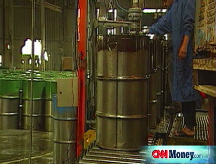Dollar rebounds on UK weakness
The greenback recovers after British GDP shows zero growth. Bernanke comments have little impact.
NEW YORK (CNNMoney.com) -- The dollar staged a rebound Friday, after a report on the United Kingdom's economy showed lower-than-expected growth.
Comments by Federal Reserve Chairman Ben Bernanke that persistent problems in the financial markets threaten the nation's economy did little to change the dollar's upward move.
The 15-nation euro traded at $1.48, down from $1.49 late Thursday. The greenback bought ¥110.08, up from ¥108.44.
Global economies slow: The dollar was sharply higher versus the pound after the United Kingdom's 2nd-quarter gross domestic product was revised to no growth, below economists' forecast of a 0.2% increase, according to Tom Benfer, director of foreign exchange at Bank of Montreal.
The pound was trading at $1.8526 Friday, sharply below $1.8778 late Thursday. When "one currency moves that far, the other currencies follow to an extent," said Benfer.
This follows reports showing economic declines in the quarter in both Japan and the euro zone, said Vassili Serebriakov, currency strategist at Wells Fargo.
"We have seen strong evidence that economic growth is slowing globally," he said.
As other economies struggle, the dollar has had an opportunity to climb. "A number of economies are slowing sharply - that has helped the U.S. dollar over the past couple weeks," said Serebriakov.
The dollar has been trending higher for the past 2 weeks. "The events of the previous 2 weeks strongly suggest that we have seen the cyclical bottom in the U.S. dollar," said Serebriakov.
Bernanke: The Fed Chairman spoke about the economy at an annual Jackson Hole, Wyo., symposium sponsored by the Kansas City Federal Reserve.
"Although we have seen improved functioning in some markets, the financial storm that reached gale force some weeks before our last meeting here in Jackson Hole [last August] has not yet subsided," Bernanke said. "Its effects on the broader economy are becoming apparent in the form of softening economic activity and rising unemployment."
"The initial reaction as far as the dollar is concerned is muted," according to Benfer. The stock market firmed after the speech, however, and he said that is "generally supportive of the dollar."
"He did indicate that the Fed is watching developments very, very closely - they are not taking their eye off the ball," said Benfer.
"The markets are looking for a blueprint, a battle plan, a sense of direction," said Benfer. "If the markets get some sense that the central bank, the Treasury have their arms around this - even if it takes a long time - that will be a positive."
Dollar and oil: Oil prices tumbled by the 2nd-largest 1-day drop ever, in dollar terms, on the back of the stronger dollar. Crude futures closed $6.59 per barrel lower to settle at $114.59 on the New York Mercantile Exchange.
The drop in the price of oil was the biggest single-day fall in dollar terms since Jan. 17, 1991, when oil fell by $10.56.
On Thursday, the dollar lost ground on fresh concerns about the financial sector. As the dollar weakened, investors moved their funds into the commodity market, helping oil prices jump more than $6 a barrel.
"The key short-term driver [for the dollar] has really been the oil price," said Serebriakov.
High oil prices hurt U.S. companies and consumers, affecting economic growth.
"Higher oil prices have significant effect on the U.S. growth - that is the primary reason why oil is bad for the dollar," said Serebriakov.
In addition, a weaker dollar makes oil cheaper to foreign investors, because crude oil is traded in U.S. currency globally. In addition, when investors watch the dollar fall, commodities appear to be a safe haven for their assets.
"The oil and the dollar have moved together, but it is not a simple answer as to what is driving what," said Serebriakov. "They go hand in hard, and it is the chicken-and-the-egg problem." ![]()




